Seismic Assessment of RC Bridge Columns Retrofitted with Near-Surface Mounted Shape Memory Alloy Technique
Abstract
:1. Introduction
2. Research Significance
3. Shape Memory Alloy
4. Numerical Investigation of Bridge Columns
4.1. Bridge Model Description
4.2. Proposed Retrofitting Technique
4.3. Fiber Element Model
4.4. Description of Uniaxial Material Models
4.4.1. Concrete
4.4.2. Reinforcing Steel
4.4.3. NSM-SMA Bars
4.5. Validation of Numerical Model
5. Static Pushover Analysis
5.1. Displacement Ductility
5.1.1. Discussion of the Displacement Ductility
5.1.2. Discussion of the Effect of NSM-SMA Bars on The Yield Displacement
6. Cyclic Loading Analysis
6.1. Relative Self Centering
Discussion of the Relative Self-Centering
6.2. Equivalent Viscous Damping Ratio
Discussion of the Damping Ratio
7. Parametric Study
7.1. Effect of NSM-SMA Bar Size
7.2. Effect of Number of FRP Layer
8. Comparison to an NSM FRP Strengthened RC Column
9. Conclusions
- (1)
- All retrofitted columns with this proposed technique exhibited improvement in displacement ductility capacity compared with as-built columns. Among all retrofitted columns the columns C-C-SMA2 and R-B-SMA2 showed greater deformation capacity and displacement ductility.
- (2)
- The columns retrofitted with CuAlMn and NiTi and FRP jacket alloys did not show an enhancement in displacement ductility compared with those retrofitted with FRP jacket only.
- (3)
- This study indicated that the NSM-SMA bars had increased the yield displacement of the RC columns remarkably. This plays an important role in reducing the ductility demand of the RC bridge columns in the seismic zones.
- (4)
- At the same lateral strength level, as expected, the columns retrofitted with NSM-FeMnSi bars did not reduce the residual displacement. This is because this alloy does not have superelastic behavior. On the other hand, the columns retrofitted with NSM-CuAlNi bars showed better self-centering capacity.
- (5)
- In general, the efficiency of this proposed retrofitting technique in improving self-centering capacity was better in rectangular cross-section columns than circular cross-section ones. This is because the NSM-SMA bars were distributed along the circumference of the circular columns.
- (6)
- The columns retrofitted with NSM-FeMnSi bars and FRP jackets dissipated higher amounts of energy than other retrofitted columns. It is found also that the larger self-centering happened the lower damping ratio generated. This is attributed to the superelastic behavior of NSM-SMA bars.
- (7)
- Increasing the NSM-FeNCATB bar size decreased the displacement ductility of the column C-C-SMA2 and at the same time did not improve the self-centering capacity than that obtained when the column C-C-SMA2 retrofitted with φ8 NSM bar. While for the column R-B-SMA2, the relative self-centering of the R-B-SMA2 column was highly improved by increasing the NSM bar size.
- (8)
- It was found also, the FRP jackets played an important role in the enhancement of the effect of this proposed technique. However, increasing the number of FRP up a certain number did not affect the self-centering capacity of the RC columns.
- (9)
- Compared with NSM-BFRP, the proposed retrofitting technique showed better performance in terms self-centering capability.
Author Contributions
Funding
Conflicts of Interest
References
- Aashto, L. AASHTO LRFD Bridge Design Specifications; American Association of State Highway and Transportation Officials: Washington, DC, USA, 2012. [Google Scholar]
- Buckle, I.G.; Friedland, I.; Mander, J.B.; Martin, G.; Nutt, R.; Power, M. Seismic Retrofitting Manual for Highway Structures: Part 1-Bridges; Federal Highway Administration: Washington, DC, USA, 2006.
- Saiidi, M.S.; Wang, H. Exploratory study of seismic response of concrete columns with shape memory alloys reinforcement. ACI Mater. J. 2006, 103, 436. [Google Scholar]
- Haroun, M.A.; Elsanadedy, H.M. Fiber-reinforced plastic jackets for ductility enhancement of reinforced concrete bridge columns with poor lap-splice detailing. J. Bridge Eng. 2005, 10, 749–757. [Google Scholar] [CrossRef]
- Saadatmanesh, H.; Ehsani, M.R.; Jin, L. Seismic strengthening of circular bridge pier models with fiber composites. ACI Struct. J. 1996, 93, 639–738. [Google Scholar]
- Seible, F.; Burgueno, R.; Abdallah, M.; Nuismer, R. Advanced composite carbon shell systems for bridge columns under seismic loads. In Proceedings of the National Seismic Conference on Bridges and Highways, San Diego, CA, USA, 10–13 December 1995; p. 16. [Google Scholar]
- ElGawady, M.; Endeshaw, M.; McLean, D.; Sack, R. Retrofitting of rectangular columns with deficient lap splices. J. Compos. Constr. 2010, 14, 22–35. [Google Scholar] [CrossRef]
- Harajli, M.H. Seismic behavior of RC columns with bond-critical regions: Criteria for bond strengthening using external FRP jackets. J. Compos. Constr. 2008, 12, 69–79. [Google Scholar] [CrossRef]
- Shin, M.; Andrawes, B. Lateral cyclic behavior of reinforced concrete columns retrofitted with shape memory spirals and FRP wraps. J. Struct. Eng. 2011, 137, 1282–1290. [Google Scholar] [CrossRef]
- Perrone, M.; Barros, J.A.; Aprile, A. CFRP-based strengthening technique to increase the flexural and energy dissipation capacities of RC columns. J. Compos. Constr. 2009, 13, 372–383. [Google Scholar] [CrossRef]
- Bournas, D.A.; Triantafillou, T.C. Flexural strengthening of RC columns with NSM FRP or stainless steel. ACI Struct. J. 2009, 106, 495–505. [Google Scholar]
- Sarafraz, M.E.; Danesh, F. New technique for flexural strengthening of RC columns with NSM FRP bars. Mag. Concr. Res. 2012, 64, 151–161. [Google Scholar] [CrossRef]
- Barros, J.A.; Ferreira, D.R.; Fortes, A.S.; Dias, S.J. Assessing the effectiveness of embedding CFRP laminates in the near surface for structural strengthening. Constr. Build. Mater. 2006, 20, 478–491. [Google Scholar] [CrossRef] [Green Version]
- Barros, J.A.; Varma, R.K.; Sena-Cruz, J.M.; Azevedo, A.F. Near surface mounted CFRP strips for the flexural strengthening of RC columns: Experimental and numerical research. Eng. Struct. 2008, 30, 3412–3425. [Google Scholar] [CrossRef] [Green Version]
- Ding, L.; Wu, G.; Yang, S.; Wu, Z. Performance advancement of RC columns by applying basalt FRP composites with NSM and confinement system. J. Earthq. Tsunami 2013, 7, 1350007. [Google Scholar] [CrossRef]
- Fahmy, M.F.; Wu, Z. Exploratory study of seismic response of deficient lap-splice columns retrofitted with near surface–mounted basalt FRP bars. J. Struct. Eng. 2016, 142, 04016020. [Google Scholar] [CrossRef]
- Seifi, A.; Hosseini, A.; Marefat, M.S.; Khanmohammadi, M. Seismic retrofitting of old-type RC columns with different lap splices by NSM GFRP and steel bars. Struct. Des. Tall Spec. 2018, 27, e1413. [Google Scholar] [CrossRef]
- Wu, Y.-F.; Liu, T.; Wang, L. Experimental investigation on seismic retrofitting of square RC columns by carbon FRP sheet confinement combined with transverse short glass FRP bars in bored holes. J. Compos. Constr. 2008, 12, 53–60. [Google Scholar] [CrossRef]
- El-Maaddawy, T.; El-Dieb, A.S. Near-surface-mounted composite system for repair and strengthening of reinforced concrete columns subjected to axial load and biaxial bending. J. Compos. Constr. 2010, 15, 602–614. [Google Scholar] [CrossRef]
- DesRoches, R.; McCormick, J.; Delemont, M. Cyclic properties of superelastic shape memory alloy wires and bars. J. Struct. Eng. 2004, 130, 38–46. [Google Scholar] [CrossRef]
- Wilde, K.; Gardoni, P.; Fujino, Y. Base isolation system with shape memory alloy device for elevated highway bridges. Eng. Struct. 2000, 22, 222–229. [Google Scholar] [CrossRef]
- DesRoches, R.; Delemont, M. Seismic retrofit of simply supported bridges using shape memory alloys. Eng. Struct. 2002, 24, 325–332. [Google Scholar] [CrossRef]
- Andrawes, B.; DesRoches, R. Comparison between shape memory alloy seismic restrainers and other bridge retrofit devices. J. Bridge Eng. 2007, 12, 700–709. [Google Scholar] [CrossRef]
- Motahari, S.; Ghassemieh, M.; Abolmaali, S. Implementation of shape memory alloy dampers for passive control of structures subjected to seismic excitations. J. Constr. Steel Res. 2007, 63, 1570–1579. [Google Scholar] [CrossRef]
- Aryan, H.; Ghassemieh, M. A superelastic protective technique for mitigating the effects of vertical and horizontal seismic excitations on highway bridges. J. Intell. Mater. Syst. Struct. 2017, 28, 1533–1552. [Google Scholar] [CrossRef]
- Aryan, H.; Ghassemieh, M. Mitigation of vertical and horizontal seismic excitations on bridges utilizing shape memory alloy system. Adv. Mater. Res. 2014, 831, 90–94. [Google Scholar] [CrossRef]
- Shahverdi, M.; Czaderski, C.; Motavalli, M. Iron-based shape memory alloys for prestressed near-surface mounted strengthening of reinforced concrete beams. Constr. Build. Mater. 2016, 112, 28–38. [Google Scholar] [CrossRef]
- Youssef, M.; Alam, M.; Nehdi, M. Experimental investigation on the seismic behavior of beam-column joints reinforced with superelastic shape memory alloys. J. Earthq. Eng. 2008, 12, 1205–1222. [Google Scholar] [CrossRef]
- Shrestha, B.; Hao, H. Parametric study of seismic performance of super-elastic shape memory alloy-reinforced bridge piers. Struct. Infrastruct. Eng. 2016, 12, 1076–1089. [Google Scholar] [CrossRef]
- Billah, A.M.; Alam, M.S. Performance-based seismic design of shape memory alloy–reinforced concrete bridge piers. I: Development of performance-based damage states. J. Struct. Eng. 2016, 142, 04016140. [Google Scholar] [CrossRef]
- Duerig, T.W.; Melton, K.; Stöckel, D. Engineering Aspects of Shape Memory Alloys; Butterworth-Heinemann: Oxford, UK, 2013. [Google Scholar]
- Otsuka, K.; Wayman, C.M. Shape Memory Materials; Cambridge university press: Cambridge, UK, 1999. [Google Scholar]
- Tanaka, Y.; Himuro, Y.; Kainuma, R.; Sutou, Y.; Omori, T.; Ishida, K. Ferrous polycrystalline shape-memory alloy showing huge superelasticity. Science 2010, 327, 1488–1490. [Google Scholar] [CrossRef]
- Omori, T.; Ando, K.; Okano, M.; Xu, X.; Tanaka, Y.; Ohnuma, I.; Kainuma, R.; Ishida, K. Superelastic effect in polycrystalline ferrous alloys. Science 2011, 333, 68–71. [Google Scholar] [CrossRef]
- Araki, Y.; Endo, T.; Omori, T.; Sutou, Y.; Koetaka, Y.; Kainuma, R.; Ishida, K. Potential of superelastic Cu-Al-Mn alloy bars for seismic applications. Earthq. Eng. Struct. Dyn. 2011, 40, 107–115. [Google Scholar] [CrossRef]
- Dong, Z.; Klotz, U.E.; Leinenbach, C.; Bergamini, A.; Czaderski, C.; Motavalli, M. A Novel Fe-Mn-Si Shape Memory Alloy with Improved Shape Recovery Properties by VC Precipitation. Adv. Eng. Mater. 2009, 11, 40–44. [Google Scholar] [CrossRef]
- Leinenbach, C.; Kramer, H.; Bernhard, C.; Eifler, D. Thermo-Mechanical Properties of an Fe-Mn-Si-Cr-Ni-VC Shape Memory Alloy with Low Transformation Temperature. Adv. Eng. Mater. 2012, 14, 62–67. [Google Scholar] [CrossRef]
- Lee, W.; Weber, B.; Feltrin, G.; Czaderski, C.; Motavalli, M.; Leinenbach, C. Phase transformation behavior under uniaxial deformation of an Fe-Mn-Si-Cr-Ni-VC shape memory alloy. J. Mater. Sci. Eng. A 2013, 581, 1–7. [Google Scholar] [CrossRef]
- Czaderski, C.; Shahverdi, M.; Brönnimann, R.; Leinenbach, C.; Motavalli, M. Feasibility of iron-based shape memory alloy strips for prestressed strengthening of concrete structures. Constr. Build. Mater. 2014, 56, 94–105. [Google Scholar] [CrossRef]
- Saiidi, M.S.; O’Brien, M.; Sadrossadat-Zadeh, M. Cyclic Response of Concrete Bridge Columns Using Superelastic Nitinol and Bendable Concrete. ACI Struct. J. 2009, 106, 69–77. [Google Scholar]
- Muntasir Billah, A.H.M.; Alam, M.S. Seismic Fragility Assessment of Concrete Bridge Pier Reinforced with Superelastic Shape Memory Alloy. Earthq. Spectra 2015, 31, 1515–1541. [Google Scholar] [CrossRef]
- Andrawes, B.; Shin, M.; Wierschem, N. Active confinement of reinforced concrete bridge columns using shape memory alloys. J. Bridge Eng. 2009, 15, 81–89. [Google Scholar] [CrossRef]
- Ghassemieh, M.; Mostafazadeh, M.; Sadeh, M.S. Seismic control of concrete shear wall using shape memory alloys. J. Intell. Mater. Syst. Struct. 2012, 23, 535–543. [Google Scholar] [CrossRef]
- Shrestha, K.C.; Araki, Y.; Nagae, T.; Koetaka, Y.; Suzuki, Y.; Omori, T.; Sutou, Y.; Kainuma, R.; Ishida, K. Feasibility of Cu-Al-Mn superelastic alloy bars as reinforcement elements in concrete beams. Smart Mater. Struct. 2013, 22, 025025. [Google Scholar] [CrossRef]
- Kawashima, K.; Hosotani, M.; Yondea, K. Carbon Fiber Sheet Retrofit of Reinforced Concrete Bridge Piers Toward New Generation Seismic Design Methodology of Bridges; Tokyo Institute of Technology: Tokyo, Japan, 2001. [Google Scholar]
- Caltrans, S.D.C. Caltrans Seismic Design Criteria Version 1.6.; California Department of Transportation: Sacramento, CA, USA, 2010.
- Sarafraz, M.E. Flexural Strengthening of RC Columns with Low Longitudinal Steel Ratio using GFRP Bars. Int. J. Concr. Struct. Mater. 2019, 13, 42. [Google Scholar] [CrossRef]
- Yuan, F.; Wu, Y.-F.; Li, C.-Q. Modelling plastic hinge of FRP-confined RC columns. Eng. Struct. 2017, 131, 651–668. [Google Scholar] [CrossRef]
- Paulay, T.; Priestley, M.N. Seismic Design of Reinforced Concrete and Masonry Buildings; Wiley-Interscience: New York, NY, USA, 1992. [Google Scholar]
- Gu, D.-S.; Wu, Y.-F.; Wu, G.; Wu, Z.-S. Plastic hinge analysis of FRP confined circular concrete columns. Constr. Build. Mater. 2012, 27, 223–233. [Google Scholar] [CrossRef]
- Lam, L.; Teng, J. Design-oriented stress-strain model for FRP-confined concrete. Constr. Build. Mater. 2003, 17, 471–489. [Google Scholar] [CrossRef]
- Kent, D.C.; Park, R. Flexural members with confined concrete. J. Struct. Div. 1971, 97, 1969. [Google Scholar]
- Braga, F.; Gigliotti, R.; Laterza, M. Analytical stress-strain relationship for concrete confined by steel stirrups and/or FRP jackets. J. Struct. Eng. 2006, 132, 1402–1416. [Google Scholar] [CrossRef]
- D’Amato, M.; Braga, F.; Gigliotti, R.; Kunnath, S.; Laterza, M. A numerical general-purpose confinement model for non-linear analysis of R/C members. Comput. Struct. 2012, 102, 64–75. [Google Scholar] [CrossRef]
- Menegotto, M. Method of analysis for cyclically loaded RC plane frames including changes in geometry and non-elastic behavior of elements under combined normal force and bending. In Proceeding of IABSE Symposium on Resistance and Ultimate Deformability of Structures Acted on by Well Defined Repeated Loads, Lisbon, Portugal, 1973; IABSE: Zurich, Switzerland, 1973; Volume 3, pp. 15–22. [Google Scholar]
- Christopoulos, C.; Tremblay, R.; Kim, H.-J.; Lacerte, M. Self-centering energy dissipative bracing system for the seismic resistance of structures: Development and validation. J. Struct. Eng. 2008, 134, 96–107. [Google Scholar] [CrossRef]
- Daghash, S.M.; Ozbulut, O.E. Bond-slip behavior of superelastic shape memory alloys for near-surface-mounted strengthening applications. Smart Mater. Struct. 2017, 26, 035020. [Google Scholar] [CrossRef]
- Federal Emergency Management Agency. Prestandard and Commentary for the Seismic Rehabilitation of Buildings; American Society of Civil Engineers (ASCE): Washington, DC, USA, 2000. [Google Scholar]
- Park, R. Ductility evaluation from laboratory and analytical testing. In Proceedings of the 9th World Conference on Earthquake Engineering, Tokyo-Kyoto, Japan, 2–9 August 1988; pp. 605–616. [Google Scholar]
- Sideris, P.; Aref, A.J.; Filiatrault, A. Quasi-static cyclic testing of a large-scale hybrid sliding-rocking segmental column with slip-dominant joints. J. Bridge Eng. 2014, 19, 04014036. [Google Scholar] [CrossRef]
- Billah, A.M.; Alam, M.S. Probabilistic seismic risk assessment of concrete bridge piers reinforced with different types of shape memory alloys. Eng. Struct. 2018, 162, 97–108. [Google Scholar] [CrossRef]



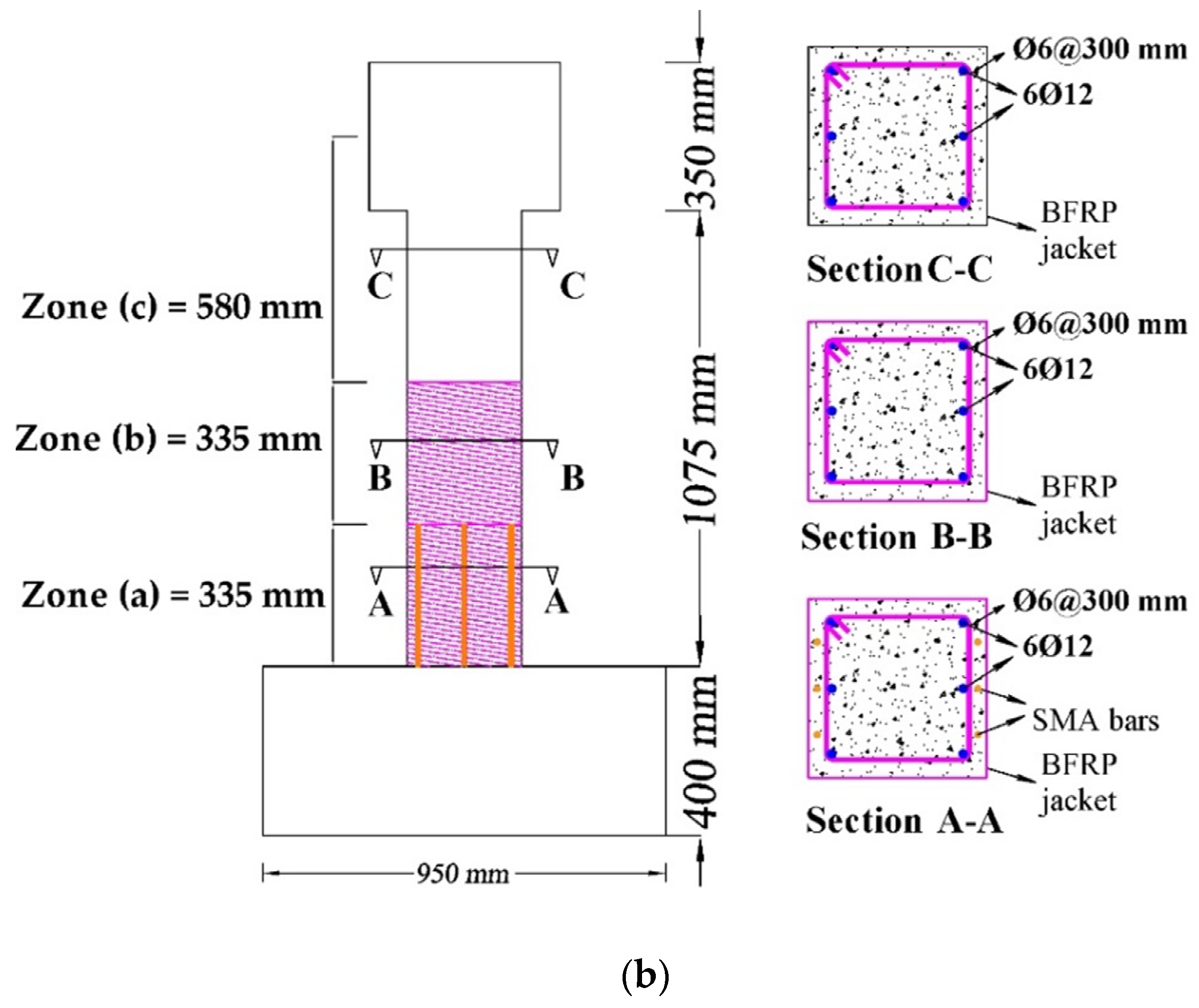

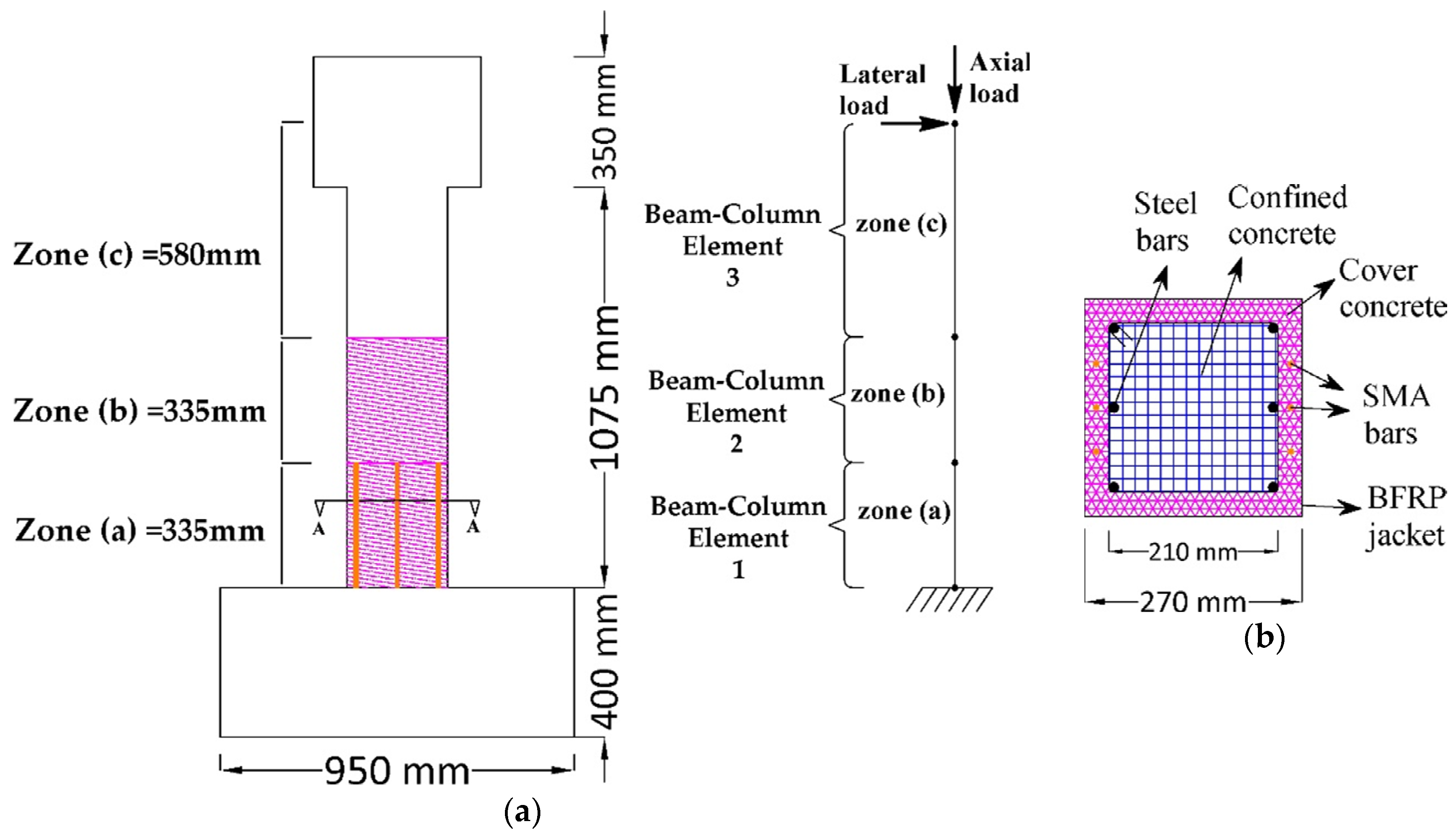
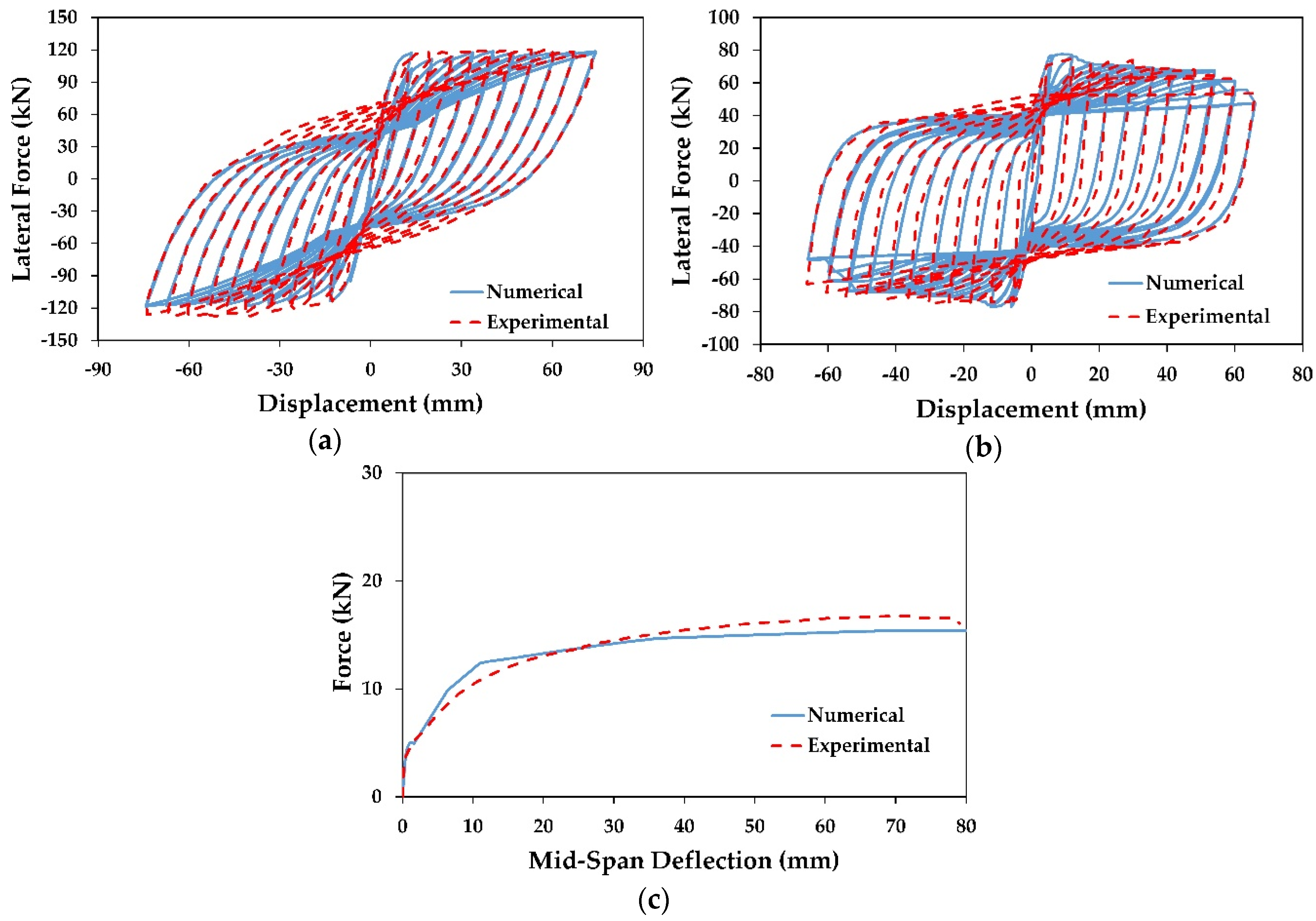

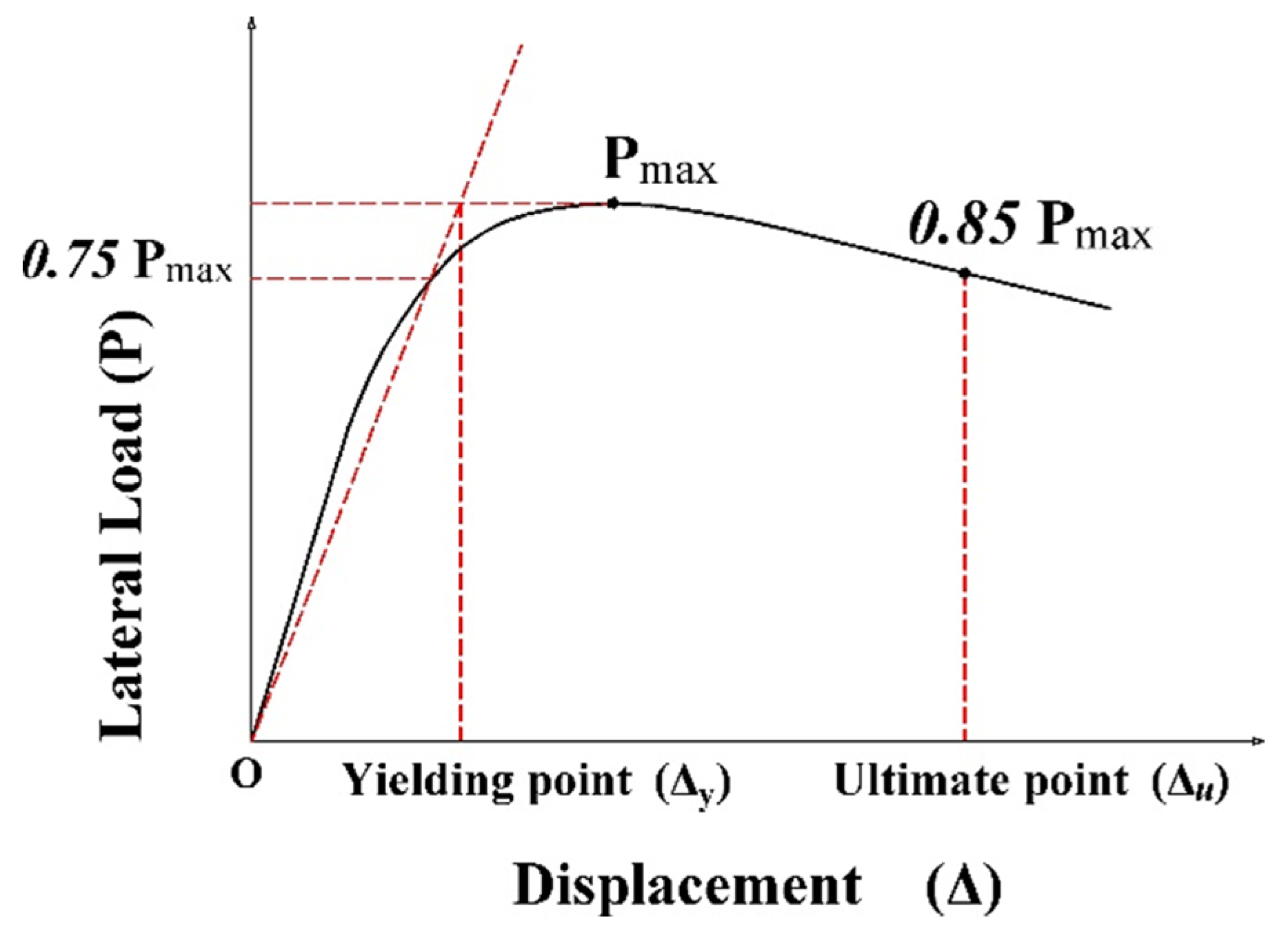





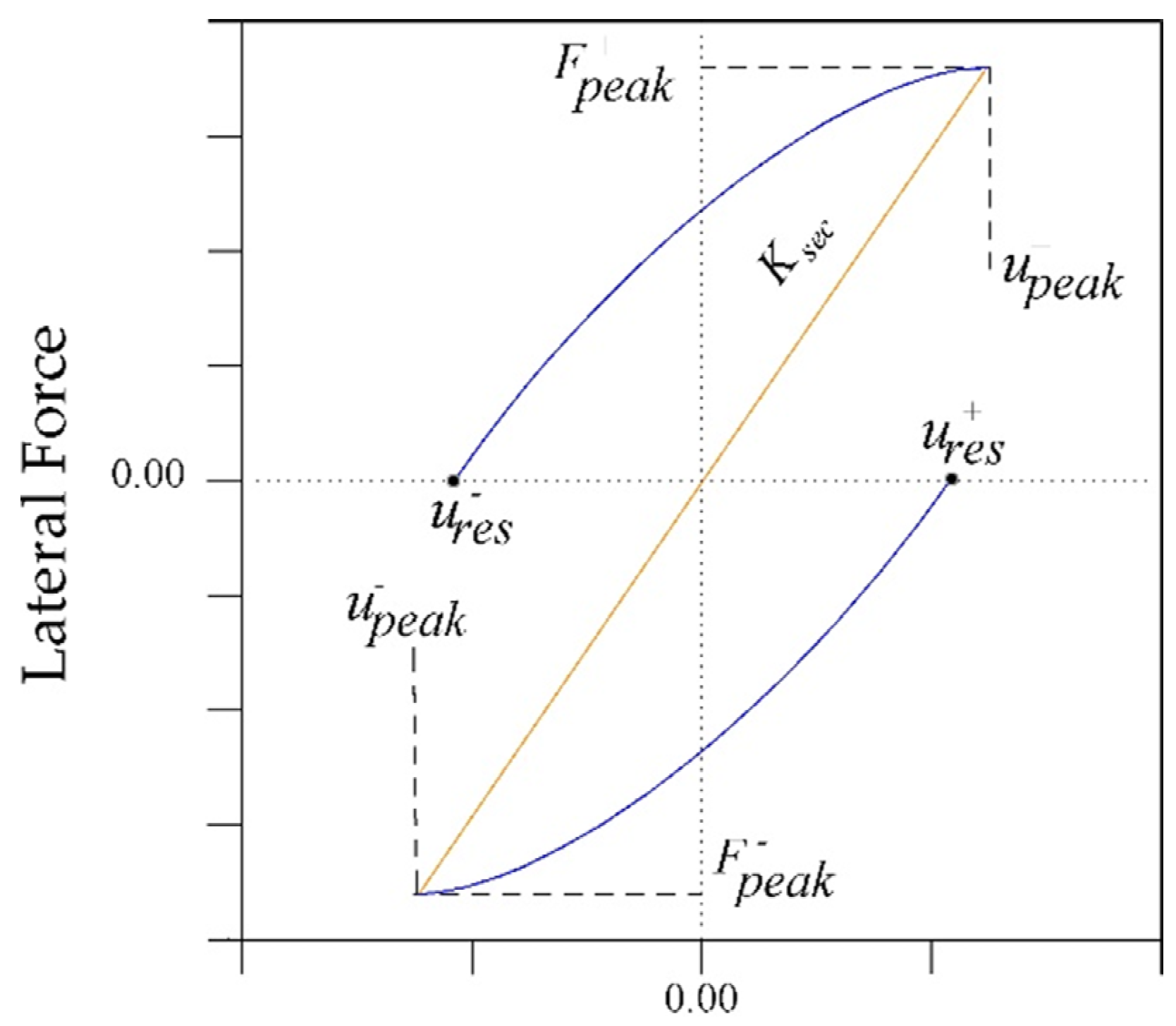
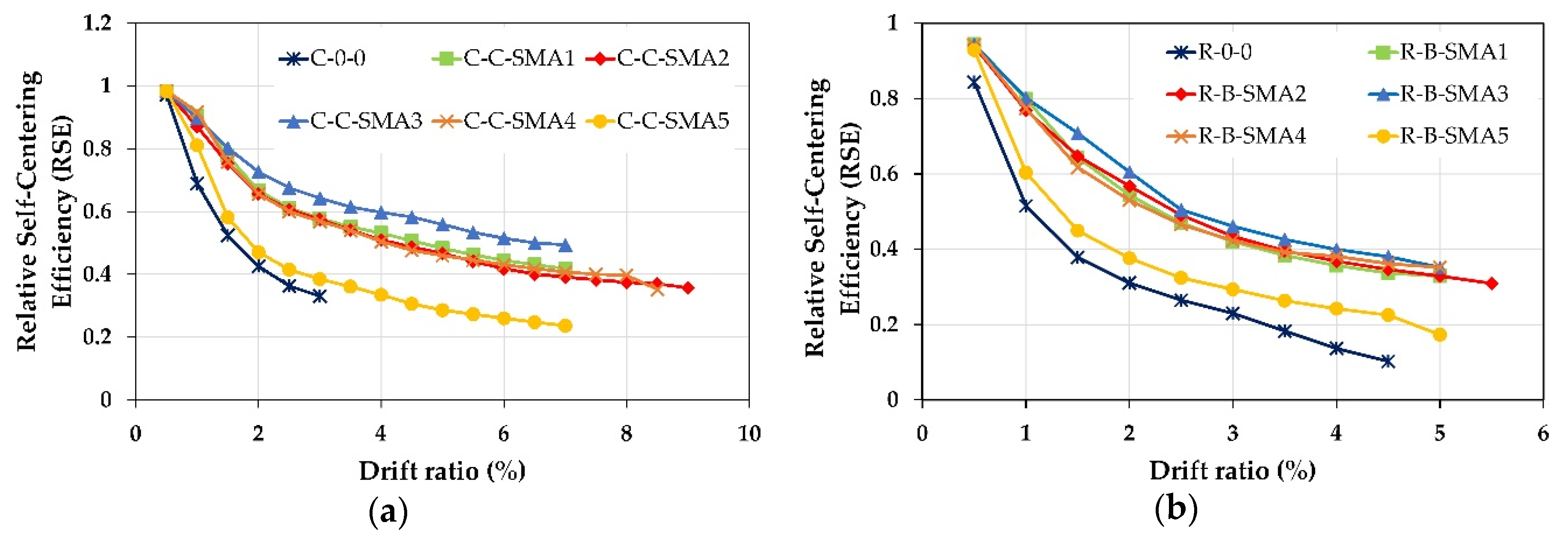
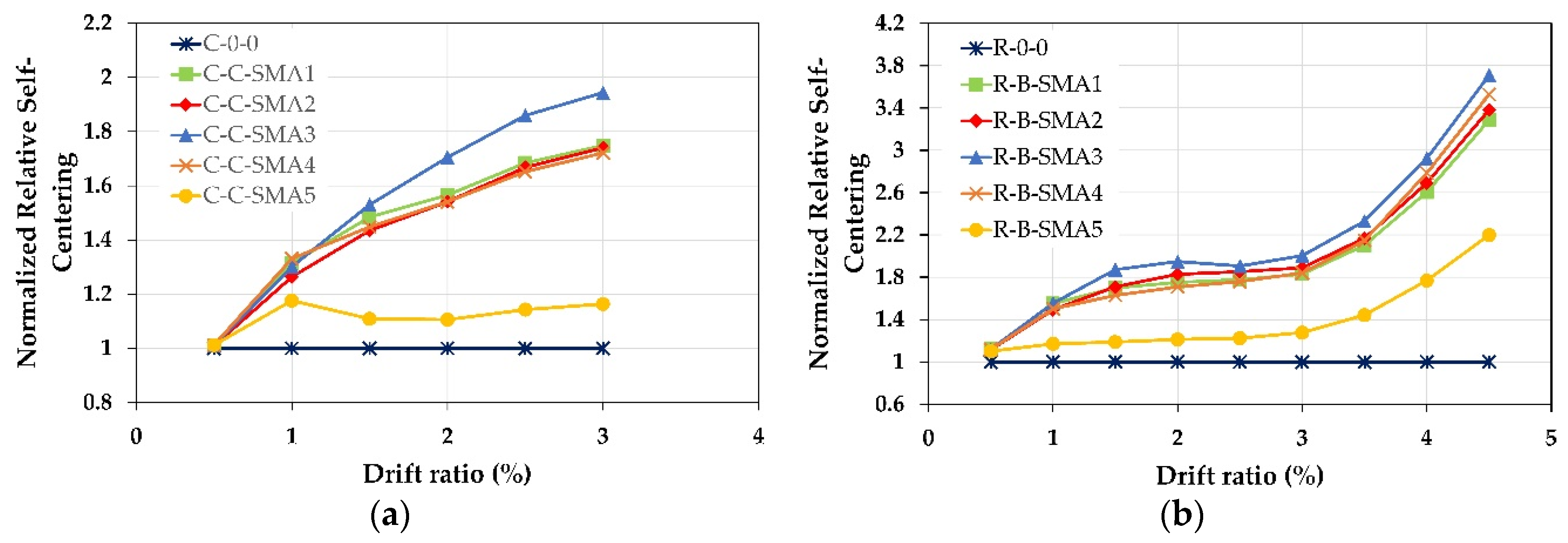

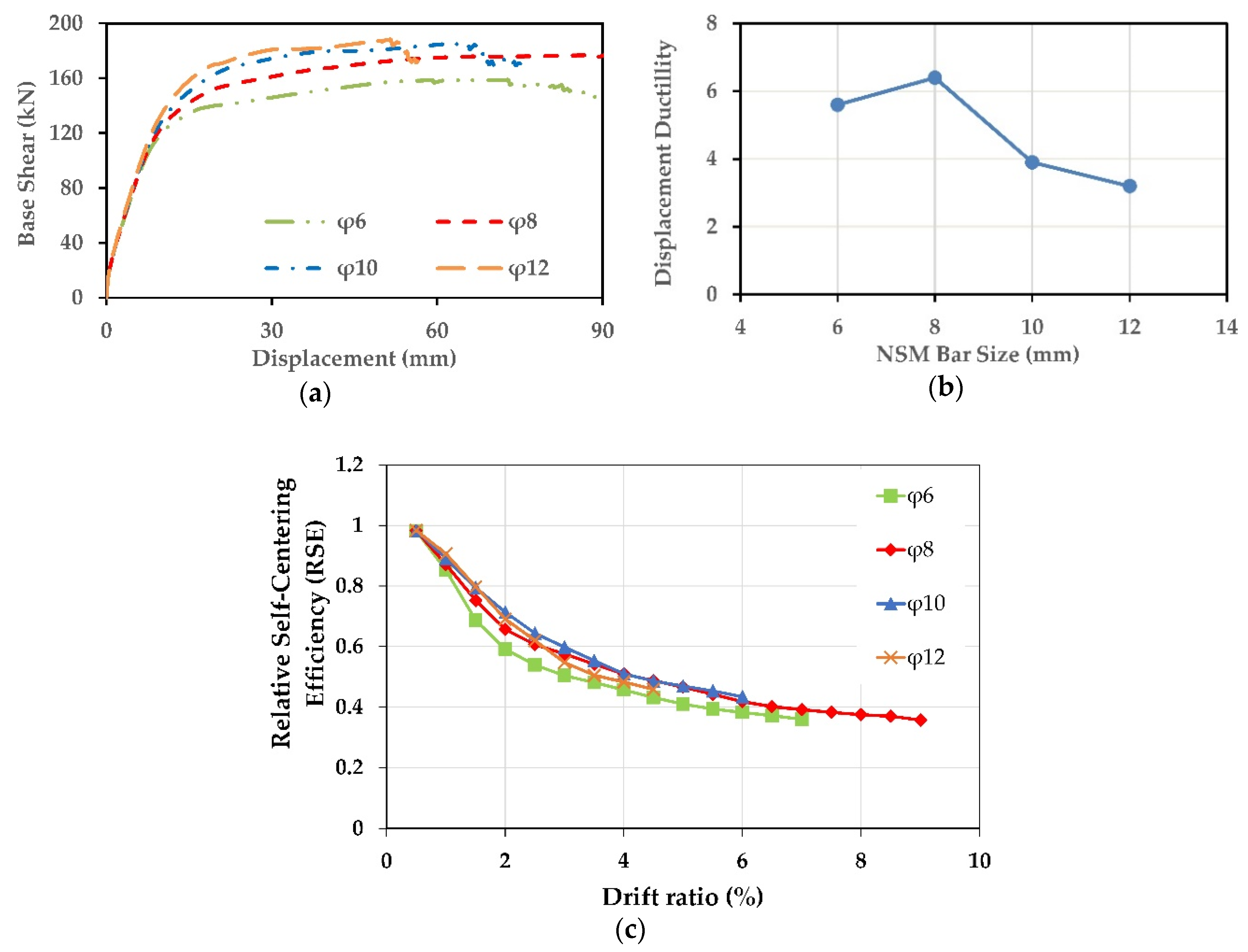

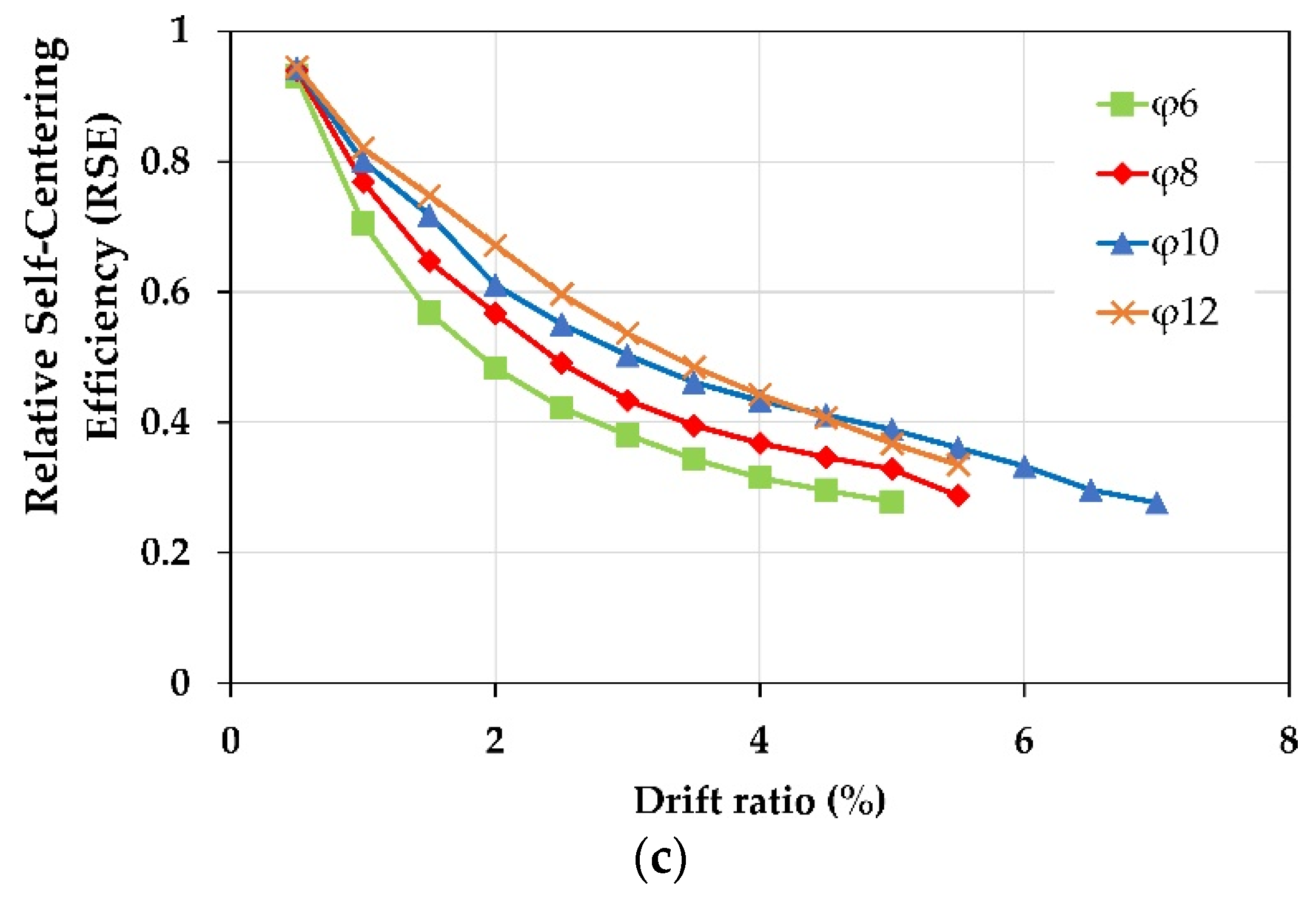



| Alloy | (%) | E (Gpa) | (Mpa) | (Mpa) | (Mpa) | (Mpa) | Reference | |
|---|---|---|---|---|---|---|---|---|
| NiTi45 | 8 | 68 | 435 | 535 | 335 | 170 | 0.0064 | Ghassemieh et al. [43] |
| FeNCATB | 13.5 | 46.9 | 750 | 1200 | 300 | 200 | 0.0160 | Tanaka et al. [33] |
| CuAlMn | 9 | 28 | 210 | 275 | 200 | 150 | 0.0075 | Shrestha et al. [44] |
| FeMnAlNi | 6.13 | 98.4 | 320 | 442.5 | 210 | 122 | 0.0033 | Omori et al. [34] |
| Bridge column Properties | Circular | Rectangular |
|---|---|---|
| Cross-section dimension (mm) | Diameter 400 | 270 × 270 |
| Effective height of column (mm) | 1350 | 1250 |
| Longitudinal reinforcement ratio (%) | 1.89 | 0.93 |
| Volumetric ratio of lateral reinforcement (%) | 0.128 | 1.60 |
| Compressive strength of concrete (MPa) | 30 | 29.65 |
| Yield strength of longitudinal rebar (MPa) | 374 | 465 |
| Yield strength of transverse rebar (MPa) | 363 | 342 |
| Axial load (kN) | 188 | 206 |
| FRP Properties | BFRP | CFRP |
|---|---|---|
| n | 3 | 1 |
| t (mm) | 0.11 | 0.111 |
| (MPa) | 1716 | 4476 |
| (GPa) | 88 | 266 |
| Column ID | Retrofitting Type | |
|---|---|---|
| Group1 | C-0-0 | As-built, not retrofitted |
| C-C-SMA1 | retrofitted with CFRP jacket and NSM NiTi45 bars | |
| C-C-SMA2 | retrofitted with CFRP jacket and NSM FeNCATB bars | |
| C-C-SMA3 | retrofitted with CFRP jacket and NSM CuAlMn bars | |
| C-C-SMA4 | retrofitted with CFRP jacket and NSM FeMnAlNi bars | |
| C-C-SMA5 | retrofitted with CFRP jacket and NSM FeMnSi bars | |
| Group2 | R-0-0 | As-built, not retrofitted |
| R-B-SMA1 | retrofitted with BFRP jacket and NSM NiTi45 bars | |
| R-B-SMA2 | retrofitted with BFRP jacket and NSM FeNCATB bars | |
| R-B-SMA3 | retrofitted with BFRP jacket and NSM CuAlMn bars | |
| R-B-SMA4 | retrofitted with BFRP jacket and NSM FeMnAlNi bars | |
| R-B-SMA5 | retrofitted with BFRP jacket and NSM FeMnSi bars |
| Research | NSM Reinforcements Type | Steel Reinforcements Ratio (%) | NSM Reinforcements Ratio (%) |
|---|---|---|---|
| Sarafraz [47] | GFRP bar | 0.785 | 0.502–0.785–1.13 |
| Barros et al. [14] | CFRP strips | 0.785–1.13 | 0.25 |
| Ding et al. [15] | BFRP bars | 0.93 | 0.28-0.43-0.62 |
| Seifi et al. [17] | GFRP bars | 0.985 | 0.5 |
| steel bars | 0.985 | 0.723 |
| Material Model | Property | Columns Group 1 | Columns Group 2 |
|---|---|---|---|
| Unconfined concrete | Compressive Strength (MPa) | 30 | 29.65 |
| Strain at peak stress (%) | 0.002 | 0.002 | |
| Modulus of elasticity (MPa) | 27380 | 27227 | |
| Confined concrete | Compressive strength (MPa) | 32 | 36.47 |
| Strain at peak stress (%) | 0.0025 | 0.004 | |
| Modulus of elasticity (MPa) | 27380 | 27227 | |
| Longitudinal steel | Young’s modulus (GPa) | 149.6 | 214.15 |
| Yield Strength (MPa) | 374 | 465 | |
| Ultimate strength | 420 | 594 | |
| Yield strain (%) | 0.0025 | 0.00217 |
© 2020 by the authors. Licensee MDPI, Basel, Switzerland. This article is an open access article distributed under the terms and conditions of the Creative Commons Attribution (CC BY) license (http://creativecommons.org/licenses/by/4.0/).
Share and Cite
Abbass, A.; Attarnejad, R.; Ghassemieh, M. Seismic Assessment of RC Bridge Columns Retrofitted with Near-Surface Mounted Shape Memory Alloy Technique. Materials 2020, 13, 1701. https://doi.org/10.3390/ma13071701
Abbass A, Attarnejad R, Ghassemieh M. Seismic Assessment of RC Bridge Columns Retrofitted with Near-Surface Mounted Shape Memory Alloy Technique. Materials. 2020; 13(7):1701. https://doi.org/10.3390/ma13071701
Chicago/Turabian StyleAbbass, Ammar, Reza Attarnejad, and Mehdi Ghassemieh. 2020. "Seismic Assessment of RC Bridge Columns Retrofitted with Near-Surface Mounted Shape Memory Alloy Technique" Materials 13, no. 7: 1701. https://doi.org/10.3390/ma13071701





